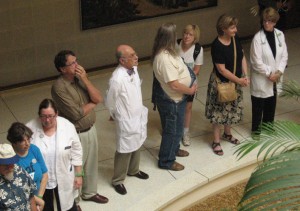North Carolina Health Care Workers Join Protests at Legislature
This is repost from North Carolina Health News, a North Carolina nonprofit, NCHN is an independent news organization devoted to covering health care in the state. This post is written by Rose Hoban. Rose is a member of CHMP’s National Advisory Council.
“Moral Monday” protests sponsored by the NAACP have been drawing larger crowds each week. This Monday, a number of health care workers turned out to protest and be arrested in acts of civil disobedience.
By Rose Hoban
Jonathan Kotch is 65 years old and is something of a political firebrand. As the leader of the group Health Care for All NC, he’s worked to create access to health care as a human right and advocated for a single-payer health insurance plan for all Americans for years. But the public health professor from UNC-Chapel Hill has never been arrested as a form of protest.
Donna Shelton (white coat, left), Jonathan Kotch (white coat, middle) and Ann Newman (white coat, right) wait to be arrested outside the doors of the Senate chamber.
Until Monday night.
Kotch was one of several dozen health care professionals who came to the General Assembly on Monday to protest the legislature’s positions on social issues, including health care, and one of a handful who wore their white coats as they were led away in handcuffs by police. The protest was the largest yet in a series of events on Monday evenings sponsored by the NAACP.
“Health care providers were specifically invited to show up here today,” Kotch said as he waited to be arrested outside the large brass doors of the North Carolina Senate. “Health is a major problem that the legislature and the governor are not paying attention to.”
Kotch said the decision to get arrested wasn’t an easy one.
“It’s a major leap to make the decision to put yourself on the line, commit civil disobedience and get arrested,” he said. “It’s a big choice, and I respect people who are not ready to do that yet.”
Kotch was one of more than 150 protesters who were taken away in zip-tie handcuffs. Police estimated more than 1,000 people showed up to protest before the arrests on the mall behind the North Carolina State Legislative Building.
Medicaid expansion decision still argued
“[The legislature] is cutting my taxes by 50 percent and they’re going to tax food, medicines and doctor visits, which will kill the retired and those on fixed incomes,” said prominent UNC researcher Charles van der Horst. (continue here)
This is repost from North Carolina Health





